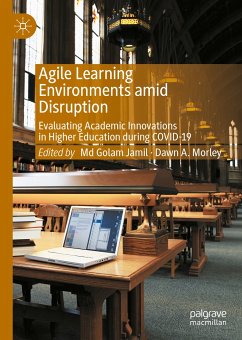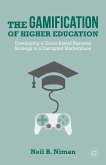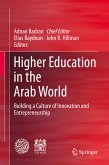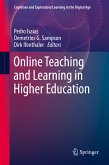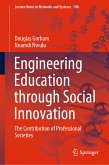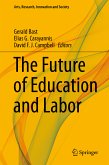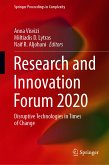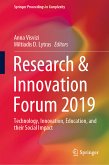Agile Learning Environments amid Disruption (eBook, PDF)
Evaluating Academic Innovations in Higher Education during COVID-19
Redaktion: Jamil, Md Golam; Morley, Dawn A.


Alle Infos zum eBook verschenken

Agile Learning Environments amid Disruption (eBook, PDF)
Evaluating Academic Innovations in Higher Education during COVID-19
Redaktion: Jamil, Md Golam; Morley, Dawn A.
- Format: PDF
- Merkliste
- Auf die Merkliste
- Bewerten Bewerten
- Teilen
- Produkt teilen
- Produkterinnerung
- Produkterinnerung

Hier können Sie sich einloggen

Bitte loggen Sie sich zunächst in Ihr Kundenkonto ein oder registrieren Sie sich bei bücher.de, um das eBook-Abo tolino select nutzen zu können.
This edited collection addresses the need of evaluating innovative or non-traditional academic schemes for understanding their feasibility in extraordinary educational environments. The individual chapters are enriched with robust appraisals of policies and practices linked to academic innovations in higher education during the unprecedented COVID-19 pandemic. The case studies report wide-ranging teaching, learning and academic support practices within online, open, blended and distance learning models. The findings supply two domains of scholarship: evidence-based scenarios through real-world…mehr
- Geräte: PC
- ohne Kopierschutz
- eBook Hilfe
- Größe: 14.58MB
![The Gamification of Higher Education (eBook, PDF) The Gamification of Higher Education (eBook, PDF)]() N. NimanThe Gamification of Higher Education (eBook, PDF)81,95 €
N. NimanThe Gamification of Higher Education (eBook, PDF)81,95 €![Higher Education in the Arab World (eBook, PDF) Higher Education in the Arab World (eBook, PDF)]() Higher Education in the Arab World (eBook, PDF)73,95 €
Higher Education in the Arab World (eBook, PDF)73,95 €![Online Teaching and Learning in Higher Education (eBook, PDF) Online Teaching and Learning in Higher Education (eBook, PDF)]() Online Teaching and Learning in Higher Education (eBook, PDF)81,95 €
Online Teaching and Learning in Higher Education (eBook, PDF)81,95 €![Engineering Education through Social Innovation (eBook, PDF) Engineering Education through Social Innovation (eBook, PDF)]() Douglas GorhamEngineering Education through Social Innovation (eBook, PDF)40,95 €
Douglas GorhamEngineering Education through Social Innovation (eBook, PDF)40,95 €![The Future of Education and Labor (eBook, PDF) The Future of Education and Labor (eBook, PDF)]() The Future of Education and Labor (eBook, PDF)105,95 €
The Future of Education and Labor (eBook, PDF)105,95 €![Research and Innovation Forum 2020 (eBook, PDF) Research and Innovation Forum 2020 (eBook, PDF)]() Research and Innovation Forum 2020 (eBook, PDF)113,95 €
Research and Innovation Forum 2020 (eBook, PDF)113,95 €![Research & Innovation Forum 2019 (eBook, PDF) Research & Innovation Forum 2019 (eBook, PDF)]() Research & Innovation Forum 2019 (eBook, PDF)113,95 €
Research & Innovation Forum 2019 (eBook, PDF)113,95 €-
-
-
Md Golam Jamil is Senior Lecturer in Academic Development at Leeds Trinity University, UK. Prior to this role, he worked as Researcher (Assessment) at the University of Bristol and Research Fellow (Research-informed Teaching) at Solent University. Golam is Senior Fellow of Advance HE, UK.
Dawn A. Morley is Principal Academic in adult nursing and leads a new registered nurse degree apprenticeship at Bournemouth University, UK. She has previously worked in academic development and has published extensively in alternative pedagogies including editing three previous collections. Dawn is Senior Fellow of Advance HE, UK.
Dieser Download kann aus rechtlichen Gründen nur mit Rechnungsadresse in A, B, BG, CY, CZ, D, DK, EW, E, FIN, F, GR, HR, H, IRL, I, LT, L, LR, M, NL, PL, P, R, S, SLO, SK ausgeliefert werden.
- Produktdetails
- Verlag: Springer International Publishing
- Seitenzahl: 818
- Erscheinungstermin: 12. Dezember 2022
- Englisch
- ISBN-13: 9783030929794
- Artikelnr.: 66918173
- Verlag: Springer International Publishing
- Seitenzahl: 818
- Erscheinungstermin: 12. Dezember 2022
- Englisch
- ISBN-13: 9783030929794
- Artikelnr.: 66918173
- Herstellerkennzeichnung Die Herstellerinformationen sind derzeit nicht verfügbar.
